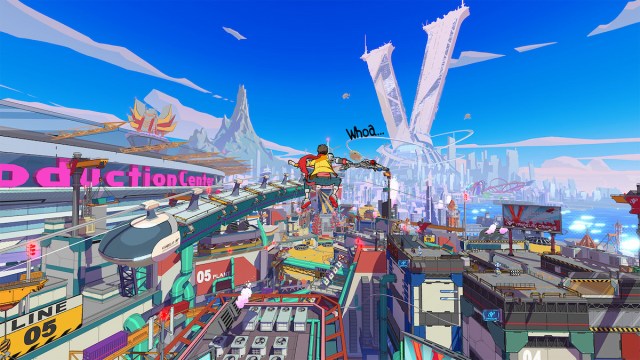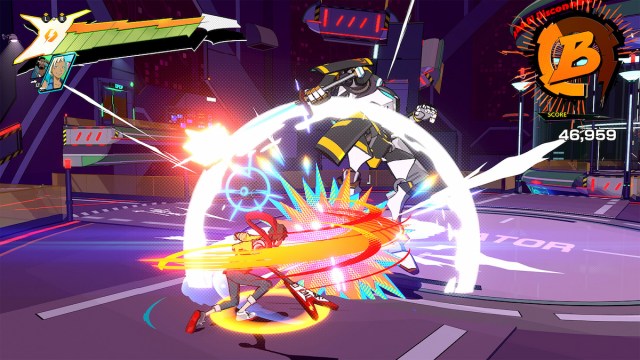Occasionally, a video game comes out that rocks so hard, we forget we’ve been trudging along through a sea of mediocrity in the modern-day gaming landscape. We usually see it coming from miles away – prolonged marketing campaigns and countless trailers serve as constant reminders to get excited, and stay excited, for the next big release. Expectations are built high, promises are stacked up, and if we’re lucky, we’re left with an enjoyable product that justifies the premium prices we pay these days.
Tango Gameworks, creators of the survival-horror franchise The Evil Within, chose to march to the beat of their own drum, blindsiding the world with the surprise release of Hi-Fi Rush – a bold move that may just be the gaming equivalent of the 1969 rooftop show by The Beatles. Yes, I did just make that comparison. You may say I’m a blasphemer, but I’m not the only one.
How Sweet the Sound

Hi-Fi Rush stars Chai, our overconfident, endearing idiot of a protagonist with high aspirations of musical stardom. After volunteering himself for a robotic arm replacement, his MP3 player is mistakenly fused into his chest, syncing his body and the world around him to the beat of his playlist. While it serves as a clever plot device to justify being a rhythm-based action game, it also garners the attention of the Vandelay Technologies security force, who sends forth countless patrols of robots to terminate what they deem a ‘defect’.
Along the way, Chai teams up with a ragtag group of brilliantly written sidekicks, forming a quintet that bursts with personality throughout the game. Well, a sextet, really, as it would be criminal to not include 808 – your mechanical feline companion who’s quickly becoming one of gaming’s most beloved little helpers.
A story’s cast is only as good as the writing behind it, and while Hi-Fi Rush is chock-full of goofy jokes and quirky exchanges between its characters, it’s all beautifully matched with the overall tone. The game knows exactly what it is and what it isn’t, blending comical tropes, fourth wall breaks, and various pop culture references in between its tongue-in-cheek dialogue. The self-awareness of Hi-Fi Rush means its consistent flow of jokes actually land, and for the first time since I can remember, I found myself constantly laughing out loud at a video game.

What makes Hi-Fi Rush so special and, frankly, so damn impressive, is that it perfectly executes everything it aims to be. As I progressed further and further into the game, I tried searching for anything that even slightly bothered me, and I simply fell short. The jumping felt a little weird at first, maybe? Perhaps the handful of early-game tutorials that briefly interrupted the flow of the introduction? After every dive back into the game, I just kept having more and more fun.
Each stage is structured much like a living, breathing song; where the verses consist of platforming segments with collectibles strewn in every which way, some in plain sight, while others hidden behind nooks and crannies. The chorus rolls in, leading Chai into small battle arenas where the Devil May Cry-styled rhythm action takes full effect. The pattern repeats a couple of times, throwing an oddball into the mix here and there, before crescendoing into a final boss battle. Each subsequent level adds another layer to the combat system, keeping the gameplay loop fresh and exciting after each mission.
“What makes Hi-Fi Rush so special and, frankly, so damn impressive, is that it perfectly executes everything it aims to be.”
Where many rhythm games begin to lose players comes down to their accessibility, or lack thereof, which Hi-Fi Rush makes sure to compensate for. Rather than punishing those who have trouble keeping up with the tempo, Chai’s attacks are always synced to the music and are simply boosted with a little more damage when inputted right on the beat. This not only keeps the combat naturally flowing but helps make the game more approachable to those who may have shrugged off the rhythm games of the past.
The fluid, flashy combat, and stupidly entertaining cutscenes are even further enhanced by Hi-Fi Rush’s ridiculously good-looking art direction, which may possibly be the best use of cel-shading I’ve ever seen in any type of media. The seamless transitions between 3D gameplay, into 2D animation, then to 3D rendering, then back into 3D gameplay is actually mind-blowing. It’s really something you’ve got to see for yourself to fully appreciate, but the fact that the animation team at Tango Gameworks was able to pull it off so beautifully is reason alone to consider Hi-Fi Rush one of the most creatively ambitious games we’ve seen in a long time.

We haven’t even touched on the stellar list of licensed and original music accompanying you through each stage, the sheer number of extra combos and abilities to add to your already-hefty arsenal, or the fact that 808 makes the digital cowbell sounds of a traditional TR-808 drum machine when she hops around.
The truth is that Tango Gameworks just set the bar for 2023, and what was supposed to be a seemingly predictable year of releases has exploded into something nobody saw coming. Hi-Fi Rush is overflowing with personality, undeniable charm, and a style so unique, it’s almost impossible not to tap your feet along with it.

- Bursting with vibrant colors and style
- Combat is engaging and easy to learn
- Comedic timing that doesn't miss
- Can get lost in combat due to abundant flashy effects
- Air velocity takes a little getting used to
- Only one song by The Prodigy





Published: Jan 28, 2023 02:06 am